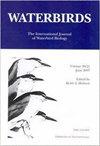Composition and Structure of Mixed-Species Foraging Aggregations of Waterbirds in Las Salinas, Ciénaga de Zapata, Cuba
IF 0.6
4区 生物学
Q3 ORNITHOLOGY
引用次数: 1
Abstract
Abstract. Mixed-species foraging aggregations of waterbirds result from foraging and anti-predator behaviors, and understanding the dynamics of these aggregations is useful in planning the conservation of waterbirds species and understanding their ecological functions within the ecosystem. This paper describes the dynamics in composition and structure of mixed-species foraging aggregations during the wet and dry seasons in the lagoon system of Las Salinas, Ciénaga de Zapata, Cuba. We surveyed these aggregations monthly from 2009 to 2017. Aggregation structure was analysed through relative abundance per guild, percentage of presence, and participation weight and participation rate. Forty-two mixed-species foraging aggregations of waterbirds were observed throughout the study, with greater species richness (n = 12 species, confidence interval: 10–13) and number of individuals (n = 800 individuals, confidence interval: 565–1,055) in the wet season. During the dry season, the most prominent species in aggregation formation were Snowy Egrets (Egretta thula), American White Ibises (Eudocimus albus) and Roseate Spoonbills (Platalea ajaja), which have been identified as nuclear species in other studies. In the wet season, American White Pelicans (Pelecanus erythrorhynchos) appeared to be the nuclear species within aggregations, something that had not previously been described in mixed-species aggregations of waterbirds. Confirming these nuclear species at Las Salinas is an important next step, given that conservation efforts focused on nuclear species might benefit the maintenance and function of the entire assembly.古巴西萨帕塔省拉斯萨利纳斯地区水鸟混合觅食群的组成和结构
摘要水鸟的混合觅食群体是觅食和反捕食行为共同作用的结果,了解这些群体的动态变化有助于制定水鸟物种保护规划和了解其在生态系统中的生态功能。本文研究了古巴萨帕塔省萨帕塔省拉斯萨利纳斯泻湖系统干湿季节混合物种觅食群落的组成和结构动态。从2009年到2017年,我们每月对这些聚合进行调查。通过公会的相对丰度、出席率、参与权重和参与率分析聚集结构。研究共发现42个水鸟混种觅食聚集,其中丰水期物种丰富度(n = 12种,置信区间为10 ~ 13)和个体数量(n = 800只,置信区间为565 ~ 1055)较大。在旱季,聚集形成最突出的物种是白鹭(Egretta thula)、美洲白鹮(Eudocimus albus)和玫瑰琵鹭(Platalea ajaja),这些物种在其他研究中被确定为核心物种。在雨季,美洲白鹈鹕(pelenanus erythrorhynchos)似乎是聚集中的核心物种,这在以前的混合物种聚集的水鸟中没有被描述过。在拉斯萨利纳斯确认这些核物种是重要的下一步,因为对核物种的保护工作可能有利于整个群落的维护和功能。
本文章由计算机程序翻译,如有差异,请以英文原文为准。
求助全文
约1分钟内获得全文
求助全文
来源期刊

Waterbirds
生物-鸟类学
CiteScore
1.30
自引率
0.00%
发文量
0
审稿时长
6-12 weeks
期刊介绍:
Waterbirds is an international scientific journal of the Waterbird Society. The journal is published four times a year (March, June, September and December) and specializes in the biology, abundance, ecology, management and conservation of all waterbird species living in marine, estuarine and freshwater habitats. Waterbirds welcomes submission of scientific articles and notes containing the results of original studies worldwide, unsolicited critical commentary and reviews of appropriate topics.
 求助内容:
求助内容: 应助结果提醒方式:
应助结果提醒方式:


